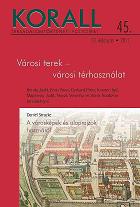A kereskedelem topográfiája. A kereskedők térhasználata a késő középkori Budán
The Topography of Trade. The Spatial Realms of Merchants in Late Medieval Buda
Author(s): Judit BendaSubject(s): History
Published by: KORALL Társadalomtörténeti Egyesület
Summary/Abstract: Reconstructing the topographical image, that is, the map of medieval Buda requires the survey of a wide range of different sources. One of the most valuable sources about the life of the city is the fifteenth-century Buda Lawbook, which contains the regulation of city authorities and a detailed description of commercial and criminal law. Another useful source are the statutes regulating the work of guilds and their members, as well as the structure and operation of the guilds. Information can also be gleaned from charters of legal cases. These often contain seemingly insignificant mentions of places, which have special importance due to the scarcity of other evidence in this field. Reconstructing the topography of Buda also greatly benefits from the fact that several military engineer visited the city during the operations aimed at reconquering the city from the Ottomans between 1684 and 1686, and their descriptions and maps are exceptionally valuable sources. The city structure and street grid, as seen on contemporary maps and etchings of the three cities (Buda, Pest, Óbuda), preserve characteristics that developed in the late medieval and Ottoman period. In addition, the architectural history of surviving buildings and the analysis of periods and building styles are also helpful in this inquiry. Research into city walls that was conducted before the post-war rebuilding works unearthed a large amount of late medieval evidence. The reassessment of the documentation and publications of their findings is essential, especially in view of international research of medieval cities, trade and architecture. Due to the international nature of trade and commerce, the building styles of medieval Europe are easily distinguishable and they are also recognisable in Hungarian buildings. Combining these different sources and methodologies, the study offers a partial reconstruction of the life of late medieval Buda. The identification of places mentioned in charters, the information provided by maps and surveillance, the architectural history of surviving buildings, as well as the material described in secondary literature lead to informed conclusions together. At the same time, the available sources are fragmentary in all groups of evidence, so the findings remain insufficient to build a complete, adequately detailed picture of the medieval city. Since surviving buildings generally preserve characteristics developed between the second half of the fourteenth and mid-sixteenth century, and most of the available documents come from this period too, the study focuses on these two hundred years.
Journal: Korall - Társadalomtörténeti folyóirat
- Issue Year: 2011
- Issue No: 45
- Page Range: 80-101
- Page Count: 22
- Language: Hungarian

